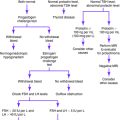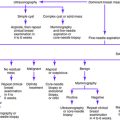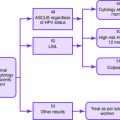Chapter 28 POLYCYSTIC OVARY SYNDROME
Polycystic ovary syndrome (PCOS) is the most common endocrine disorder in women of reproductive age. Women with PCOS often have irregular menses, obesity, infertility, and hirsutism.
Medications That May Cause Symptoms That Mimic Polycystic Ovary Syndrome
Anabolic steroids (may cause hirsutism, acne, and amenorrhea)
Danazol (may cause amenorrhea and hirsutism)
Diazoxide (may cause hirsutism)
Glucocorticoids (may cause hirsutism)
Oral contraceptives (may cause amenorrhea)
Phenytoin (may cause hirsutism)
Causes of Polycystic Ovary Syndrome
The cause of polycystic ovary syndrome is not completely understood. It involves the dysregulation of complex hormone cycles that leads to luteinizing hormone excess, androgen excess, insulin resistance, and chronic anovulation. There is a probable genetic predisposition to PCOS that is affected by environmental factors, especially obesity.
Key Historical Features:
Key Physical Findings
Suggested Work-Up
| Pregnancy test | To rule out pregnancy |
| Serum prolactin level measurement | To evaluate for hyperprolactinemia/pituitary adenoma |
| Fasting blood glucose measurement or glucose tolerance test | To evaluate for diabetes or glucose intolerance |
| Fasting lipid panel | To evaluate for hyperlipidemia |
| Thyroid-stimulating hormone measurement | To evaluate for hyper- or hypothyroidism |
| Dehydroepiandrosterone sulfate (DHEAS) | To evaluate for hyperandrogenism and rule out an androgen-producing tumor |
| Free testosterone | To evaluate for hyperandrogenism and rule out an androgen-producing tumor |
Additional Work-Up
| Pelvic ultrasonography | To evaluate for cystic ovaries, ideally performed on cycle days 3, 4, or 5 and with a vaginal probe |
| Total testosterone measurement | To evaluate for hyperandrogenism and rule out an androgen-producing tumor |
| Androstenedione measurement | To evaluate for hyperandrogenism |
| Serum 17-hydroxyprogesterone measurement | To evaluate for non-classic congenital adrenal hyperplasia |
| Dexamethasone suppression test | If Cushing syndrome is suspected |
| Twenty-four-hour urine cortisol measurement | If Cushing syndrome is suspected |
| Luteinizing hormone (LH) and follicle-stimulating hormone (FSH) measurements | For a high LH/FSH ratio, which is suggestive of PCOS (usually 3:1 or higher) |
| Estradiol level measurement | A low estradiol level in conjunction with a high FSH level is suggestive of premature ovarian failure in a patient with amenorrhea |
| Fasting insulin measurement | To evaluate for insulin resistance (a ratio of fasting glucose to insulin of 4.5 or lower indicates insulin resistance) |
| Endometrial biopsy | If endometrial hyperplasia or carcinoma is suspected |
Buccola JM, Reynolds EE. Polycystic ovary syndrome: a review for primary providers. Prim Care Clin Office Pract. 2003;30:697-710.
Buggs C, Rosenfield RL. Polycystic ovary syndrome in adolescence. Endocrinol Metab Clin. 2005;34:677-705.
Carmina E. The spectrum of androgen excess disorders. Fertil Steril. 2006;85:1582-1585.
Habif TP. Clinical Dermatology, 4th. St. Louis: Mosby, 2004.
Hart R, Norman R. Polycystic ovarian syndrome—prognosis and outcomes. Best Pract Res Clin Obstet Gynaecol. 2006;20:751-778.
Richardson MR. Current perspectives in polycystic ovary syndrome. Am Fam Physician. 2003;68:697-704.
The Rotterdam ESHRE/ASRM–Sponsored PCOS Consensus Workshop Group. Revised 2003 consensus on diagnostic criteria and long-term health risks related to polycystic ovary syndrome (PCOS). Hum Reprod. 2004;19(1):41-47.





